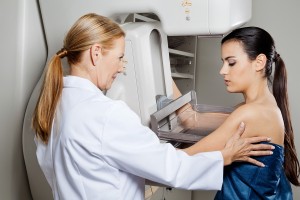Until November of 2009, most women were well aware of the recommendations for breast cancer screening. Until tha t time, all women were recommended to begin routine screening mammograms for the prevention of breast cancer at the age of 40 and every year thereafter. This was the agreed upon standard of care amongst most major medical societies until the U.S. Preventive Services Task Force (USPSTF) released an update on the recommendations.
t time, all women were recommended to begin routine screening mammograms for the prevention of breast cancer at the age of 40 and every year thereafter. This was the agreed upon standard of care amongst most major medical societies until the U.S. Preventive Services Task Force (USPSTF) released an update on the recommendations.
These new recommendations included starting routine screening mammograms at the age of 50, not 40, and only every 2 years thereafter, instead of every year, until the age of 74 after which screening is recommended to no longer be performed.
This statement started a large amount of controversy, since it deviated quite drastically from the recommendations of most Ob/Gyn specialists as well as the major medical societies who have made previous recommendations regarding screening mammograms including the American College of Obstetricians and Gynecologists (ACOG), the American Cancer Society (ACS) and the National Cancer Institute (NCI).
Understanding the Recommendations
What has to be understood is what is involved in making recommendations for any screening medical test. Considerations include the risks of a given procedure, such as the potential for harm to the person undergoing the procedure either physically or mentally, weighed against the benefits, usually measured as potential for earlier diagnosis and thus reduction in the risk of dying from the particular disease being screened for.
Mammography poses very small, but still present, risks of radiation exposure along with the possibility of false negatives, resulting in a missed diagnosis, as well as false positives, resulting in unnecessary invasive procedures being performed. This is some of the reasoning behind the changes recommended by the USPSTF.
Between the ages of 40-49, there is conflicting data regarding the benefit of mammograms when compared to the potential risks. While some studies have shown a decrease in death from breast cancer by as much as 15% in those women who undergo regular mammogram screening between the ages of 40-49, other studies have not supported this same improvement.
Younger women have more dense breast tissue which can conceal early cancers more while those breast cancers that do occur in this age group also tend to be more aggressive and faster growing, thus leading to later stage diagnosis at times.
These are just some of the reasons for the conflicting data resulting in these new recommendations. Ultimately, however, few changes have actually occurred in practice thus far despite the newer USPSTF recommendations. Luckily for women in these age groups, most insurance companies are still covering routine mammogram screening starting at the age of 40.
How Do You Decide What’s Right for You?
Well, here are the current recommendations from the medical societies that guide how most Ob/Gyn specialists practice in regards to ordering mammograms for their patients. ACOG and ACS both recommend screening mammograms every year starting at the age of 40 with no end point based on age. NCI recommends screening mammograms every 1-2 years starting at the age of 40 with no end point based on age. The best way to decide what is right for you is to discuss your options with your Ob/Gyn or primary care physician as well as become familiar with what your insurance company will cover. Recommendations can then be appropriately made for you on an individual basis given your personal preferences, your personal medical history and your family history. This allows your physician to determine your personal risk level for developing breast cancer and manage your screening appropriately.
There is no argument that routine screening mammograms have saved many lives, and will continue to do so.
Talk to your physician and make sure that you follow through with what is recommended in order to help keep you as healthy as possible. In the unfortunate situation that you become diagnosed with breast cancer, this is your best chance at finding it as early as possible and getting treatment as quickly as possible.
Referenced by:


 t time, all women were recommended to begin routine screening mammograms for the prevention of breast cancer at the age of 40 and every year thereafter. This was the agreed upon standard of care amongst most major medical societies until the U.S. Preventive Services Task Force (USPSTF) released an update on the recommendations.
t time, all women were recommended to begin routine screening mammograms for the prevention of breast cancer at the age of 40 and every year thereafter. This was the agreed upon standard of care amongst most major medical societies until the U.S. Preventive Services Task Force (USPSTF) released an update on the recommendations.